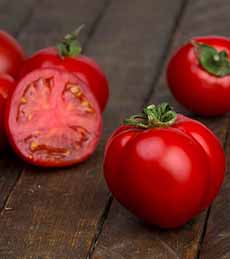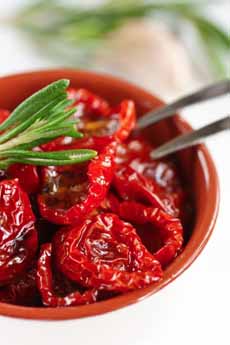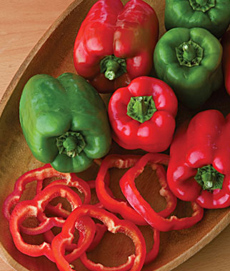TIP OF THE DAY: Tomato Substitutes
|
[6] Pimentos in jars are soft, pliant and ready for a sandwich or burger (photo © Goya). |
Even though it’s spring, it will be a few months before vine-ripened tomatoes are available. There’s nothing worse than paying good money for “slicking tomatoes,” the term our supermarkets give to tasteless tomatoes, sometimes mealy, that never ripen to a soft texture. If they’re hard, that means they’re good for slicing? That’s one angle; but those tomatoes are not good for eating. So: What should you do if you want something approximating tomato flavor plus bright color on your sandwich or in your salad? Here’s what we use. These two fruits may raise your eyebrows, but to paraphrase: “Try it, you may like it!” We have recommendations for that, too. Here they are. In all of its forms—fresh, tomato sauce. paste, juice, etc.)—the tomato is the second most widely consumed vegetable in the U.S., after the potato. The tomato is native to Mesoamerica: It was cultivated by the Aztecs and Incas. In 1519, Cortez found it growing in Montezuma’s gardens, and it became part of the culinary bounty brought back to Spain by the 16th-century conquistadors (along with cacao, chiles, potatoes, turkey and much more). Some Europeans embraced them, but many believed them to be poisonous (it’s a member of the Nightshade family, which includes some poisonous plants: and the leaves of some of the edible plants are poisonous if consumed in large quantity). French botanist Joseph Pitton de Tournefort bestowed the Latin botanical name Lycopersicon esculentum on the tomato. This translates to “wolf-peach,” a reference to the third century writings of Galen concerning a poison in a palatable package which was used to destroy wolves. The English word tomato comes from the word brought back from the New World by the Spanish, the Aztec/Nahuatl word tomatl, pronounced toe-MAH-tay. This became the Spanish word tomate: same pronunciation, different spelling. The original tomatoes were small, like cherry tomatoes, and most likely yellow rather than red. In Spain and Italy, they were known as pomi d’oro, golden apples. The original cherry tomato versions were deemed inedible and used only as decorative plants for 200 years, until famine in Italy caused starving peasants to eat them. After five centuries of breeding, there are thousands of varieties of tomatoes in a vast array of shapes, colors and sizes. The most common shapes in the U.S. are round (beefsteak and globe), pear-shaped (roma and plum) and the miniature (cherry and grape). Is the tomato a fruit or a vegetable? It is the fruit of the tomato plant. Botanically speaking, it is developed from the dry ripened ovary in the base of a flower, and contains the seed(s) of the plant (although cultivated tomatoes may be seedless). It can be further classified as a berry since it’s pulpy and has edible seeds. Apples, blueberries, oranges, pears, and raspberries are true fruits.† Many kinds of nuts are also true fruits, as are the avocado, tomato and—more surprisingly—the bean pod, bell pepper, hot chile pepper and zucchini. Science notwithstanding, on May 10, 1893, tomatoes were declared a vegetable by the United States Supreme Court. That means that: |
|
|
________________ *Common nightshade vegetables that we eat include bell peppers, chiles, eggplant, tomatoes and white potatoes. †Some plants have a soft part which supports the seeds and is also called a fruit, though it is not developed from the ovary: the strawberry, which has its seeds on the outside, is an example. |
||





